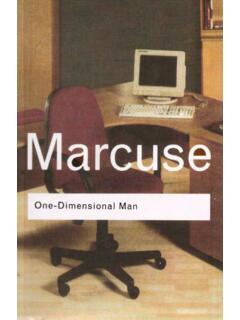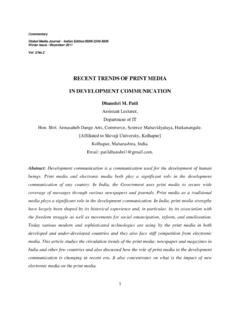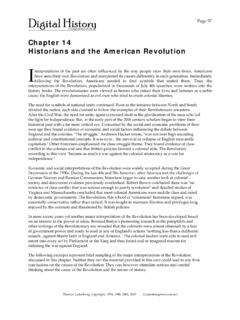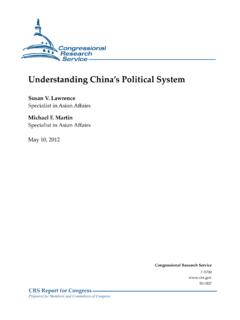Transcription of Introduction to the Curriculum Ideologies
1 111 Introduction to the Curriculum IdeologiesFor almost a hundred years, educators have been at war with each other over what the nature of the American school Curriculum should be. Underlying this war are four visions of what the school Curriculum should look like. These visions are based on four Curriculum Ideologies or Curriculum philosophies that advocate very dif-ferent purposes for schooling and very different methods of achieving those respective four visions of schooling have both stimulated improvement in American schools and caused conflicts that have inhibited progress in the development of the school competition between the four visions of education has stimulated advocates of each to develop increasingly powerful curricula, instructional methods, and research bases. The result is improved instruction for competition between the four visions of education has also made it difficult for educators and the general public to reach a consensus on the nature and purposes of the American school Curriculum .
2 Seemingly irresolvable disagreements include the reading controversies over whether it is more important to teach decoding (phonics) or comprehension (whole language), the mathematics disputes over whether it is more important to teach mathematical understanding or mathematics skills, and the history conflicts over whether it is more important to teach knowledge of the past or to build strategies for critically analyzing and reconstructing society in the future. These dis-putes have recently become so fierce that they have become known as the reading wars, the math wars, and the history wars. Inability to appreciate differences in vision for the 2 Curriculum THEORY school Curriculum and reach a consensus about critical philosophical and pedagogical issues has made systematic improvement of the Curriculum of the four visions of Curriculum embodies distinct beliefs about the type of knowledge that should be taught in schools, the inherent nature of children, what school learning consists of, how teachers should instruct children, and how children should be assessed.
3 Each vision has its own value system; its own purposes of educa-tion; its own meanings for words ( , Does knowledge consist of understandings, skills, meanings, or values?); its own heroes, whose beliefs it repeats; and its own vil-lains, whose beliefs it rails this book, these visions are labeled the Scholar Academic ideology, the Social Efficiency ideology, the Learner Centered ideology, and the Social Reconstruction ideology. Each ideology has a long history and has been known by a variety of names. For example, at different times during the last hundred years, the Learner Centered ideology has been called progressive education, open education, child-centered education, developmentally appropriate practice, and constructivism. These ide-ologies can influence people s ways of thinking about Curriculum in the same powerful ways that their political beliefs can influence their stances on political existence of these four Ideologies causes difficulty for newcomers to the field, who are usually unaware of them and, as a result, often have difficulty determining how to philosophically orient themselves as subscribers to different Ideologies pressure them for their allegiance.
4 The existence of these four Ideologies also causes concern among veteran teachers, who are frequently told by school administrators to embrace one Curriculum fad after another fads that often require major revision of the con-ceptual frameworks upon which teachers build their instruction. These Curriculum philosophies frequently cause disagreement among Curriculum workers, particularly Curriculum developers, about what the nature of the Curriculum they create and schools adopt should be. The competition among advocates of these four Curriculum Ideologies for influence on the school Curriculum also causes concern sometimes leading to the formation of political initiatives among members of the general public who are interested in how their children and grandchildren are being educated, what goes on in our schools, and the ways in which schooling is influencing children s beliefs and social orientation. The best example of these political initiatives is perhaps the Curriculum wars that took place in California between 1985 and 2000, during which two groups with competing Ideologies had each other s favored Curriculum programs removed from the list of state-funded Curriculum materials and replaced by their own programs after lengthy, well-publicized political battles (Becker & Jacob, 2000; Jackson, 1997a, 1997b; Pearson, 2004; Schoenfeld, 2004; Wilson, 2003).
5 The existence of these competing visions of what good education consists of and the corresponding lack of understanding regarding these visions among educators, Curriculum workers, and the general public causes confusion and discomfort among Americans and within American education. As individuals, we are constantly disagree-ing with each other and with ourselves about what we should be doing in our schools. As members of politically oriented groups, we lobby state departments of education over which textbooks or instructional programs should be used in our states. As a nation, we issue one prestigious report after another, many of them Chapter 1 Introduction to the Curriculum Ideologies 3disagreeing with each other, about what the problems of American education are and how those problems should be a country, we have enriched our school Curriculum in many ways by drawing from the four Ideologies . However, systematic improvement in our school Curriculum has been difficult, for we have been unable to settle on a single ideological orientation or a negotiated compromise among ideological orientations, unable to set clear goals for our schools, and unable to pursue those goals with single-minded confusion in American education that results from a lack of perspective on the four Curriculum Ideologies , ignorance about the nature of these four visions for education, and the continuing disagreement among educators and the general public over what the nature of the school Curriculum should be disrupts the effectiveness of educators as individuals and our schools as organizations (of supposedly cohesive groups of people).
6 One purpose of this book is to provide readers a sympathetic perspective on these visions of schooling based on a comprehensive understanding of the four Curriculum Ideologies in the historical context in which they have existed over the last hundred years. Another purpose of this book is to give readers perspective on their own phi-losophies of education as they relate to the four Curriculum Ideologies that have had and are currently having a profound influence on American schools. This book first describes and analyzes each of the Curriculum Ideologies , then compares them, and finally discusses the complex ways in which they influence the lives of individual edu-cators over the span of their on and understanding of these Curriculum Ideologies can have several benefits. First, when educators understand their own conceptual frameworks and the range of ideological options available to them, it can help them to more effectively clarify and accomplish their own Curriculum and instructional goals.
7 Second, when educators have perspective on and understand the range of philosophical beliefs that colleagues can hold, this can enable them to better understand the nature of curricu-lum disagreements that inevitably take place in schools, be more accepting of others, and more effectively work with people of differing opinions. Third, when educators understand the way in which language is used differently in each of the four Ideologies , it can assist them in more effectively communicating and negotiating Curriculum deci-sions with colleagues, Curriculum committees, school boards, and their communities. Fourth, when educators have perspective on and understand the differences between the Curriculum frameworks influencing the current public dialogue about education, it can facilitate their ability to more effectively contribute to the public debate about educational issues. Fifth, when educators have an understanding of the ideological pressures exerted on them by society and colleagues, this can help them put those pres-sures in perspective and minimize as warranted their influence (Cotti & Schiro, 2004).
8 In addition, when working with others on Curriculum , if educators can acknowledge and clarify the conflicts and tensions that exist among colleagues who hold different beliefs about education and who use words in different ways to express their beliefs, there arises the potential to enable those colleagues to better understand and appreciate their differences and to more constructively work together (Block, 2010, pp. 523 527).4 Curriculum THEORYYour Beliefs About CurriculumThis book is about both the nature of American education and the beliefs individuals have regarding the school Curriculum . As a result, it is highly suggested that readers complete a short inventory that allows them to visually graph their Curriculum beliefs. (The inventory and instructions for graphing its results are located in the Appendix.) I recommend that you complete the inventory now, before reading further, and again after you finish reading this book.
9 The last chapter in this book discusses how and why educators change their Curriculum Ideologies over time. Seeing how your beliefs about Curriculum change as you read this book will help you understand that Curriculum IdeologiesThe Social Efficiency ideology, the Scholar Academic ideology, the Learner Centered ideology, and the Social Reconstruction ideology are the names given to the curricu-lum Ideologies examined within this Scholar Academic IdeologyScholar Academics believe that over the centuries our culture has accumulated important knowledge that has been organized into the academic disciplines found in universities. The purpose of education is to help children learn the accumulated knowledge of our culture: that of the academic disciplines. Acquiring an understand-ing of an academic discipline involves learning its content, conceptual frameworks, and ways of thinking. Teachers should be mini-scholars who have a deep understand-ing of their discipline and can clearly and accurately present it to Academics assume that the academic disciplines, the world of the intellect, and the world of knowledge are loosely equivalent.
10 The central task of education is taken to be the extension of the components of this equivalence, both on the cultural level, as reflected in the discovery of new truth, and on the individual level, as reflected in the enculturation of individuals into civilization s accumulated knowledge and ways of academic discipline is viewed as a hierarchical community of people in search of truth within one part of the universe of knowledge. The hierarchical communities consist of inquirers into the truth (the scholars at the top of the hierarchy), teachers of the truth (those who disseminate the truth that has been discovered by the scholars), and learners of the truth (students whose job it is to learn the truth so that they may become proficient members of the discipline).The aim of education for Scholar Academics is the extension of their disciplines by introducing young people into them. This involves making youth members of a dis-cipline by first moving them into it as students and then moving them from the bottom of the hierarchy toward its top.

















